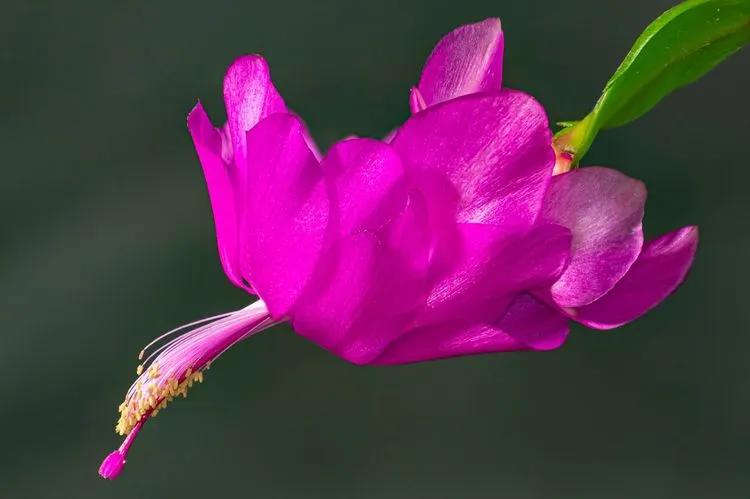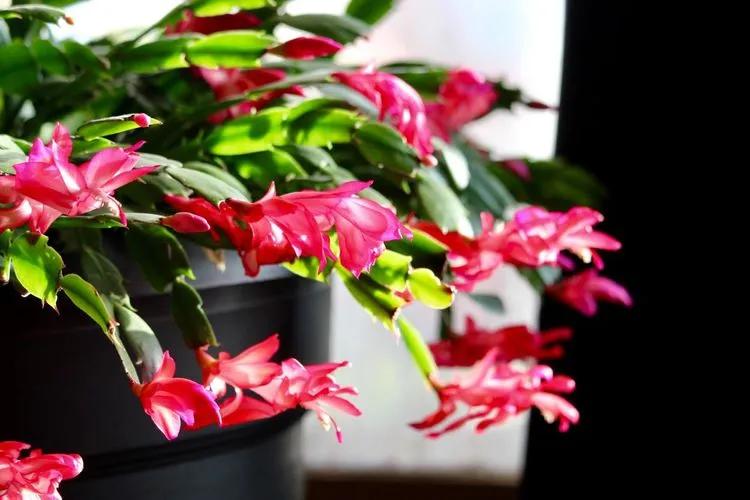 The Christmas cactus is a very popular houseplant - and for a good reason! When it blooms, Schlumbergera produces pink or purple tubular flowers. Their beautiful bloom, long flowering time, and ease of care make them wonderful plants.
The Christmas cactus is a very popular houseplant - and for a good reason! When it blooms, Schlumbergera produces pink or purple tubular flowers. Their beautiful bloom, long flowering time, and ease of care make them wonderful plants.
Basics
The Christmas tree has received its common name due to the flowering time: this succulent starts blooming in December and can keep the flowers for a long time. Vibrant flowers are about 5 cm in size, irregular in shape with protruding stamens. An adult plant reaches up to 60 cm in length, and the stems have a drooping shape, which makes it possible to grow it in hanging planters.
Watering
Like other tropical plants, the Christmas cactus needs moderate watering and responds well to regular spraying. Before watering, make sure that the ground is completely dry. Do not "flood" it with water; otherwise, the roots may start to rot, which may be indicated with withered leaves.
For watering, you must use soft settled or boiled water. Tap water is a common cause of plant death since the Christmas cactus does not tolerate high levels of chlorine and lime in the water.
Temperature
Schlumbergera is quite hardy and can survive in the temperature range of 2°C to 39°C (36-102˚F). If we talk about the optimal temperature, then in summer, it is 18-20°C degrees (64-68kF), and in winter, it is about 13-15°C (54-59˚F).
Light
The Christmas cactus is quite unpretentious in terms of lighting; theonly thing worth remembering is that it does not tolerate direct sunlight, which causes burns on the leaves. A bright place without direct daytime sunlight is best suited, with an illumination level of 70% to 85% of sunlight.
Christmas cactus life cycle

-
Rest period (October–November). At this time, the Christmas cactus needs rest, limited watering (once a week), and a short lightday. From the second half of November, plants can be watered and sprayed every other day.
-
Bud formation period (November–December). With the beginning of the formation of buds and during flowering, watering should be abundant and regular (as the soil dries up), and the temperature in the room should be about 30˚C (86˚F).
-
Flowering period (December–February). Dry air and moving the pot will cause the buds to drop. Do not rearrange or unfold the plant during flowering: the Christmas cactus will shed its beautiful flowers.
-
Growth period (March–August). During this period, your house plant needs warmth, uniform watering with soft (settled) water, and feeding 1 time in 2 weeks with special fertilizers for cacti.
Transplant and reproduction
Young plants are transplanted in mid-March every 2-3 years, and older ones - after 4-5 years. The pot should not be very widesince its root system is small. Fill the planter with drainage and substrate made of equal parts of sod, leafy soil, and sand. Christmas cactus is propagated mainly by cuttings in April–May. Stem cuttings with 2-3 segments are carefully unscrewed (but not cut!) from the mother plant, dried within 24 hours, and planted in a light, breathable substrate. Within a month, the cuttings take root. When the cutting takes root, it will release a young segment.
Pests
 The most common pest that settles on a plant and destroys it as a result of improper care is a mealybug. They are small insects covered in white fluff. These pests should be collected by hand and then sprayed with soapy water. Soap solution recipe is easy: just mix 1 tsp. soap for 6 tsp. warm water.
The most common pest that settles on a plant and destroys it as a result of improper care is a mealybug. They are small insects covered in white fluff. These pests should be collected by hand and then sprayed with soapy water. Soap solution recipe is easy: just mix 1 tsp. soap for 6 tsp. warm water.
Christmas cactus does not tolerate excessive moisture (in this case, the roots rot)or the drying out of the soil. In summer, it is advisable to take it out into fresh air, protecting it from direct sunlight, and spray it from a spray bottle.
During flowering, it is highly advisable not to move the plant to another place; otherwise, you risk that it will completely shed its buds and flowers. That is why it is recommended to replant the Christmas cactus in the spring.
The best place for a zygocactus in the house is the northeastern windows. In spring and autumn, the plant receives good sunlight in the morning hours and during the day - favorable sunlight for it. Zygocactus grows well on the north and west windows, but on the south side in spring and summer, you simply cannot do without shading.
Why do Christmas cactus buds fall off?
There may be several reasons: drafts, improper watering, temperature fluctuations, or a change in the angle of incidence of light, usually associated with a change in the location of the flower. The flower responds well to changes in the humidity of the air in the room, and since the heating season begins at the end of autumn and the air becomes dry, at this time, the Christmas cactus may lose flowers.
Why isn't the Christmas cactus blooming?
The Christmas cactus often does not bloom due to improper adherence to the temperature regime. If kept too warm in the autumn-winter period (above 23°C (73˚F)), the Christmas cactus will not bloom. At low temperatures (less than 10°C (50˚F)), the buds are not laid.
